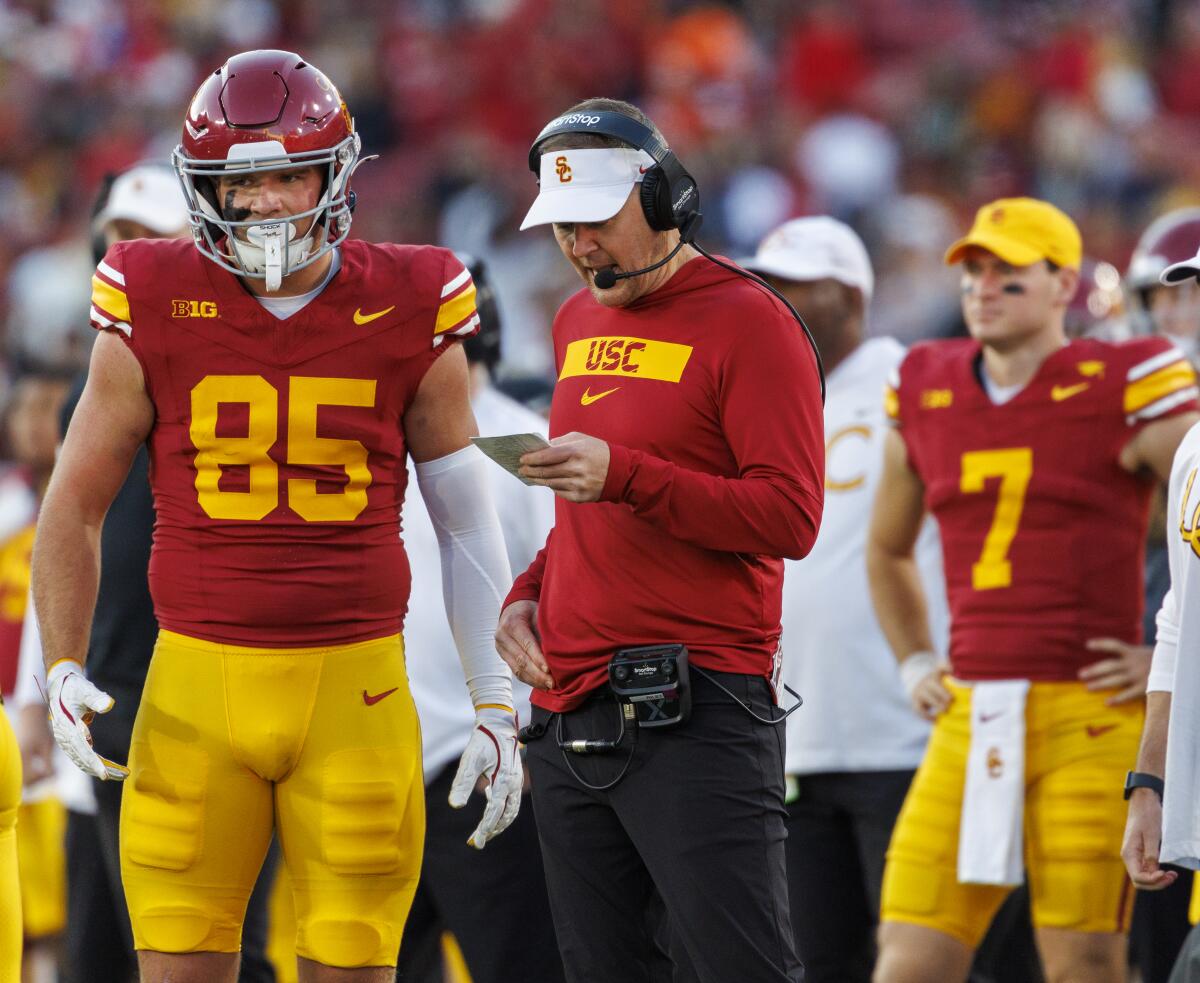USC focused on rebounding after ugly Notre Dame loss
USC had lost four of five, its season already all but lost, when Lincoln Riley made a bold move early last November that would have lasting ripple effects. He benched starting quarterback Miller Moss, in favor of backup Jayden Maiava, whose big arm and mobility gave the Trojans’ offense a different, more dynamic look.
The sudden switch made for a tense two weeks leading up to last season’s meeting with Nebraska. Not everyone in the locker room, you see, was thrilled with Moss’ removal.
But the move paid dividends in the end. Maiava injected life into the offense, USC returned from its bye and won three of its last four to finish the season. More critically, Riley found his quarterback of the future.
“The way that Jayden handled both when he wasn’t the starter, then when he was, I think set the stage for the player he has started to become and what he means to this program and this team right now,” Riley said this week. “He handled it with class both ways, and that makes a huge difference.”
USC starting quarterback Jayden Maiava throws a pass against Notre Dame at Notre Dame Stadium on Oct. 18.
(Justin Casterline / Getty Images)
A season later, USC is once again searching for answers coming out of its second bye, with Nebraska looming in November. Though, none of the questions this time concern the quarterback, who has been one of the best in the Big Ten. Nor are they as easy to solve as plugging in one player.
USC’s defensive front was just steamrolled for over 300 yards by Notre Dame’s run game. The offensive line is still dealing with nagging injuries. And the Trojans own rushing attack left a lot to be desired in their last outing.
Nevertheless, USC is 5-2, still within conceivable reach of the College Football Playoff conversation. The Trojans should be favored in four of their final five games, the lone exception being a trip to Eugene in late November. You don’t have to squint too hard to see a potential path to the Playoff … assuming USC can iron out its issues, first. That’s more encouraging than the circumstances were at this time last year.
“We’re still in a good place,” tight end Walker Lyons said. “We still control our destiny where we’re at right now.”
That’s been the message since USC left South Bend in bitter defeat. But control could slip through their hands in a hurry if Riley can’t right the ship this week on the road at Nebraska. A single loss, especially one outside of Oregon, would all but sink those hopes.
“I think we’ve learned a lot about ourselves with some of these really good matchups we’ve had as of late,” Riley said. “We know what we’ve gotta do. It’s very clear to us. Now we’ve just got to do a great job of it.”
That part hasn’t been so easy for USC as it unraveled down the stretch in each of its last three seasons. The Trojans are 6-11 in October and November since winning seven of eight during that stretch of Riley’s first campaign.
Adding a hostile road environment to that equation this week only makes matters more complicated. The Trojans haven’t won a true road game in October or November outside of Los Angeles since Oct. 28, 2023.
Nor do they seem to have pinned down precisely what’s ailing their defense at the moment. A week after one of USC’s best defensive performances of the season in a win over Michigan, the Trojans suddenly had major errors in execution, leading the Irish to rack up 306 rushing yards, the most allowed by a D’Anton Lynn-led defense. Lynn, the Trojans’ second-year coordinator, called the mistakes “extremely” frustrating.
But like Riley, he’s confident a week away will have done USC’s defense well.
“At the end of the day, when we’re on the same page, we know we can be a good defense,” Lynn said. “But we have to be on the same page and trust that the guy next to us is going to do his job, and we don’t have to overcompensate for anything.”
Notre Dame’s Jadarian Price (24) carries the ball and pulls away from USC’s Bishop Fitzgerald (19) on Oct. 18 in South Bend, Ind.
(Paul Beaty / Associated Press)
That trust comes much easier now for Maiava, after a full year as USC’s starting quarterback. Though, Nebraska and its top-rated pass defense won’t make it easy, per se. The Huskers are giving up a mere 127 yards passing per game through seven games.
It all makes for a test that the Trojans can’t afford to fail, one where its quarterback will be critical.
“Keep your head down, keep fighting,” Maiava said. “Just stay in it no matter what. We had this bye and we got to rest up a little bit which is great. But we need to be that beast every single day.”
Injury update
Left tackle Elijah Paige and center Kilian O’Connor both dressed for practice on Tuesday, but Riley expressed some doubt that USC would have its full starting offensive line available in time for Saturday’s game.
“We’re better,” Riley said, “but we’re not at a point where I’m like, ‘Yeah those guys are ready to go.’ We’re just not to that point yet.”

